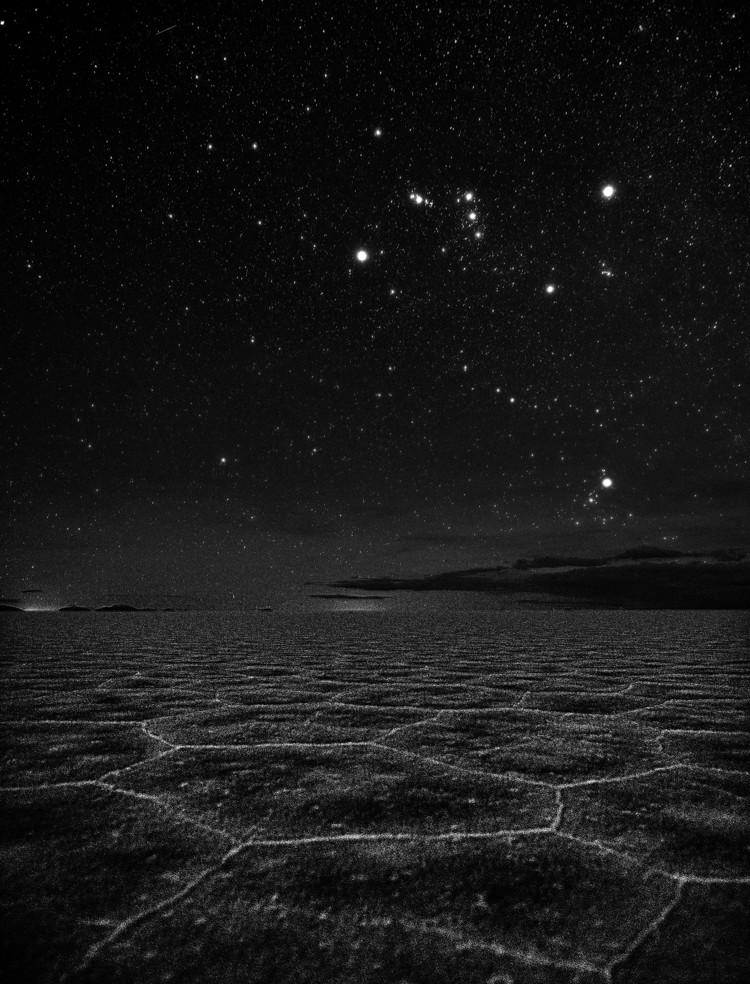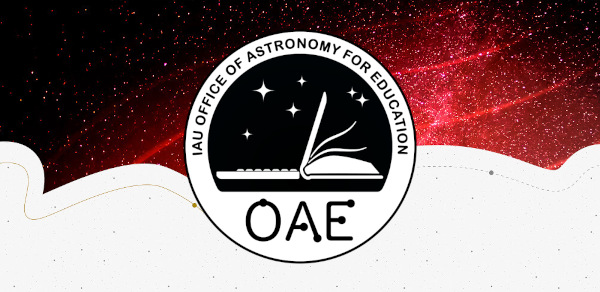This page describes an image Luminous Salar de Uyuni
Caption:
Winner in the 2022 IAU OAE Astrophotography Contest, category Still images of celestial patterns.
This black and white image taken in February 2017 in Uyuni Salt Flat of southwest Bolivia, the biggest salt flat in the world, shows one of the most recognisable constellations, Orion the hunter, and the open star cluster of the Hyades directly above the clouds at the horizon. Various cultures have different stories associated with Orion. The Aymara in this area of the world (Bolivia and Northern Chile) consider Orion’s Belt to be a Sky Bridge (chacka cilitu) or a Stairway made out of dough. This stairway is rather obvious in this picture. It appears as if the stars in the sky are scattered like grains of salt on the ground — an amazing composition.
For the Aymara, who were Christianised by the Spanish conquistadores, Orion and the Stairway are connected to the November festivals of the dead ancestors and the souls. In contrast to the original Christian culture, for these people in the southern hemisphere these festivals mark the beginning of summer, not the beginning of winter. While in the north, the “ghosts” of the ancestors are represented by the foggy weather in November, the Aymara greet the ancestors with flowers. This photograph in the dry salt flat, in contrast, seems to show the unlivable loneliness where the photographer meets the souls of the deceased.
The Yolnu people of Arnhem Land in Australia’s Northern Territory have a rich culturally significant story associated with Orion that carries a lesson. It tells of the three brothers of the Kingfish clan and their canoe Djulpan. Owing to their lack of patience, the brothers ate the sacred Kingfish, angering the Sun woman Walu who created a waterspout that sent them into the sky. Looking at the constellation Orion, the three stars in Orion’s belt represent the three brothers, Orion’s sword is the fishing line, and the two dimmer stars Bellatrix and Saiph form the two ends of the canoe Djulpan.
Credit:
Stephanie Ye Ziyi/IAU OAE
DOI: 10.5281/zenodo.7425325
Related glossary terms:
Constellation
, Orion
Categories:
Naked Eye Astronomy
, Stars
License: Creative Commons Attribution 4.0 International (CC BY 4.0) Creative Commons Attribution 4.0 International (CC BY 4.0) icons
The media file captions presented on the OAE website were written, translated and reviewed by a collective effort from the OAE, the OAE Centers and Nodes, the OAE National Astronomy Education Coordinators (NAECs) and other volunteers. You can find a full list of credits for our translation project here. All media file captions are released under a Creative Commons CC BY-4.0 license and should be credited to "IAU OAE". The media files themselves may have different licenses (see above) and should be credited as listed above under "credit".
Captions in Different Languages:
Caption: Auszeichnung beim IAU OAE Astrofoto-Wettbewerb 2022, Kategorie Weitwinkelaufnahmen von Himmelsmustern.
Dieses Schwarz-Weiß-Bild, aufgenommen im Februar 2017 in der Salzpfanne Salar de Uyuni im Südwesten Boliviens, der größten Salzwüste der Welt, zeigt eines der bekanntesten Sternbilder, den Himmelsjäger Orion, und den offenen Sternhaufen der Hyaden direkt über den Wolken am Horizont. Verschiedene Kulturen haben unterschiedliche Geschichten mit dem Orion verbunden. Die Aymara aus dieser Region der Welt (Bolivien und Nordchile) betrachten den Gürtel des Orion als eine Himmelsbrücke (chacka cilitu) oder eine aus Teig gefertigte Treppe. Die Figur der Treppe ist auf diesem Bild ziemlich offensichtlich. Es scheint, als ob die Sterne am Himmel wie Salzkörner auf dem Boden verstreut sind - eine erstaunliche Komposition.
Für die Aymara, die von den spanischen Eroberern christianisiert wurden, sind Orion und die Treppe mit den Novemberfesten der toten Ahnen und der Seelen verbunden. Im Gegensatz zu dieser ursprünglich christlichen Tradition markieren diese Feste für diese Menschen auf der Südhalbkugel allerdings den Sommeranfang und nicht den Beginn des Winters. Während auf der Nordhalbkugel die "Geister" der Ahnen durch das neblige Wetter im November repräsentiert werden, grüßen die Aymara ihre Vorfahren mit Blumen. Dieses Foto in der trockenen Salzwüste scheint dagegen die unwirtliche Einsamkeit zu zeigen, in der die Fotografin den Seelen der Verstorbenen begegnet.
Das Volk der Yolnu im Arnhem Land im australischen Northern Territory hat eine reichhaltige, kulturell bedeutsame Geschichte, die mit Orion verbunden ist und eine Lehre enthält: Sie erzählt von den drei Brüdern des Kingfish-Clans und ihrem Kanu Djulpan. Aus Mangel an Geduld aßen die Brüder den heiligen Königsfisch und verärgerten damit die Sonnenfrau Walu, die eine Wasserhose schuf, die sie in den Himmel schickte. Betrachtet man das Sternbild Orion, so stellen die drei Sterne im Gürtel des Orion die drei Brüder dar, das Schwert des Orion ist die Angelschnur, und die beiden dunkleren Sterne Bellatrix und Saiph bilden die beiden Enden des Kanus Djulpan.
Credit: Stephanie Ye Ziyi/IAU OAE
Related glossary terms: Orion , Sternbild Caption translation status: Not yet approved by a reviewer
Caption translators: Carolin Liefke
Caption: Vincitore del concorso di astrofotografia IAU OAE 2022, categoria Immagini fisse di modelli celesti.
Questa immagine in bianco e nero scattata nel febbraio 2017 nella piana salata di Uyuni, nel sud-ovest della Bolivia, il più grande deserto di sale del mondo, mostra una delle costellazioni più riconoscibili, Orione il cacciatore, e l'ammasso stellare aperto delle Iadi direttamente sopra le nuvole all'orizzonte. Varie culture hanno storie diverse associate a Orione. Gli Aymara di questa zona del mondo (Bolivia e Cile settentrionale) considerano la Cintura di Orione come un Ponte del Cielo (chacka cilitu) o una Scala fatta di pasta. La scala è piuttosto evidente in questa immagine. Sembra che le stelle del cielo siano sparse come granelli di sale sul terreno: una composizione sorprendente.
Per gli Aymara, cristianizzati dai conquistadores spagnoli, Orione e la Scala sono collegati alle feste di novembre degli antenati morti e delle anime. In contrasto con la cultura cristiana originaria, per questi popoli dell'emisfero meridionale tali festività segnano l'inizio dell'estate, non l'inizio dell'inverno. Mentre al nord i "fantasmi" degli antenati sono rappresentati dalla nebbia di novembre, gli Aymara salutano gli antenati con i fiori. Questa fotografia nell'arida piana salata, al contrario, sembra mostrare l'invivibile solitudine in cui il fotografo incontra le anime dei defunti.
Gli Yolnu della Terra di Arnhem, nel Territorio del Nord dell'Australia, hanno una ricca storia culturalmente significativa associata a Orione che porta con sé un insegnamento. Racconta dei tre fratelli del clan Kingfish e della loro canoa Djulpan. A causa della loro mancanza di pazienza, i fratelli mangiarono il sacro pesce re, facendo arrabbiare la donna del sole Walu che creò una tromba d'acqua che li mandò in cielo. Guardando la costellazione di Orione, le tre stelle della cintura di Orione rappresentano i tre fratelli, la spada di Orione è la lenza e le due stelle più fioche Bellatrix e Saiph formano le due estremità della canoa Djulpan.
Credit: Stephanie Ye Ziyi/IAU OAE
Related glossary terms: Costellazione , Orione Caption translation status: Approved by a reviewer
Caption translators: Giuliana Giobbi
Caption reviewers: Rodolfo Canestrari









